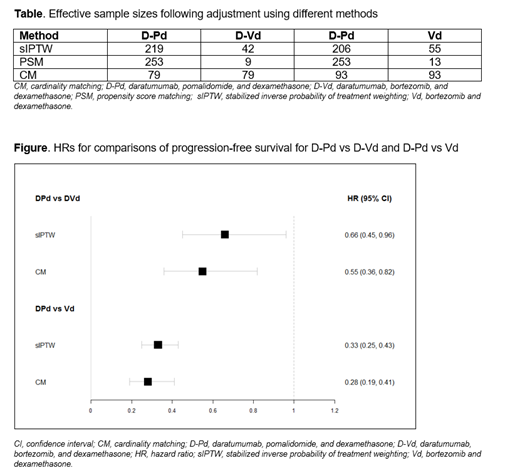Abstract
Introduction: The phase 3 APOLLO study demonstrated significantly better progression-free survival (PFS) and clinical responses with daratumumab, pomalidomide, and dexamethasone (D-Pd) vs pomalidomide and dexamethasone (Pd) alone in patients with relapsed/refractory multiple myeloma (RRMM). Based on these results, D-Pd became 1 of many treatment regimens approved in this patient population. In the absence of head-to-head data, indirect comparisons can provide important information to help optimize treatment for patients with RRMM. However, indirect comparisons of aggregated clinical trial data can be subject to selection and confounding bias, thus limiting the conclusions that can be drawn from the comparison. Several statistical methodologies are available that can be used to control for baseline differences and estimate the relative treatment effect of different treatment regimens. Here, we report the results of indirect comparisons that used patient-level data to compare improvement in PFS with D-Pd vs daratumumab, bortezomib, and dexamethasone (D-Vd) and D-Pd vs Vd in patients with RRMM with prior immunomodulatory drug (IMiD) and proteasome inhibitor (PI) exposure.
Methods: Data for the D-Pd cohort came from the APOLLO (NCT03180736) and EQUULEUS (NCT01998971) studies. APOLLO is a randomized, open-label, phase 3 trial in which patients with RRMM and ≥1 prior line of therapy (LOT) including lenalidomide and a PI were randomized to D-Pd (N=151) or Pd (N=153). EQULEUUS was a nonrandomized, open-label, phase 1b trial that evaluated D-Pd in 103 patients with RRMM and ≥1 prior LOT, including lenalidomide and a PI. Data for the D-Vd and Vd cohorts came from CASTOR (NCT02136134), a randomized, open-label, phase 3 trial comparing D-Vd (N=251) vs Vd (N=247) in patients with RRMM and ≥1 prior LOT. Harmonized eligibility criteria (≥1 prior LOT including an IMiD and a PI; no prior pomalidomide) were applied prior to weighting/matching. Stabilized inverse probability of treatment weighting (sIPTW), propensity score matching (PSM), and cardinality matching (CM) were explored to adjust for imbalances in patient characteristics at baseline. Propensity scores were estimated using logistic regression for sIPTW and PSM. CM is an optimization-based method to find the mathematically-guaranteed largest matched sample meeting prespecified maximum standardized mean difference criteria for matching covariates, thereby overcoming limitations of PSM associated with limited covariate overlap, which was identified in this sample. Age, sex, cytogenetic risk (high/standard/missing), Eastern Cooperative Oncology Group performance status (0, 1, or 2), International Staging System (ISS) stage (I, II, III, or missing), MM type (IgG/non-IgG/missing), prior autologous stem cell transplant (yes/no), number of prior LOT (1, 2-3, or ≥4), refractory to lenalidomide status (yes/no/not received), refractory to IMiD/PI status (IMiD only, PI only, both, neither), and years since diagnosis were considered for adjustment. The analysis focused on PFS; overall survival was not analyzed as these data are immature.
Results: After harmonized eligibility criteria were applied, 253, 104, and 122 patients from the D-Pd, D-Vd, and Vd cohorts, respectively, were included for comparison. A naïve comparison of baseline characteristics identified differences between D-Pd and D-Vd/Vd cohorts. After sIPTW, PSM, and CM adjusting, some imbalances between the D-Pd and D-Vd/Vd cohorts remained. ISS stage and MM type could not be adjusted for due to the amount of missing data in EQUULEUS. The CM method yielded better balance than sIPTW. The effective sample sizes (ESS) for each method are shown in the Table. The ESS for PSM was too low for comparison of PFS. PFS hazard ratios favored D-Pd over D-Vd and Vd and were statistically significant for sIPTW and CM (Figure).
Conclusions: This indirect treatment comparison showed a PFS benefit for D-Pd compared with well-established SOC regimens D-Vd and Vd in patients with RRMM with previous exposure to an IMiD and a PI. Although the low ESS of sIPTW and PSM is a limitation, these findings provide support in favor of using D-Pd in a population of patients with difficult-to-treat MM.
He: Janssen: Current Employment, Current equity holder in publicly-traded company. Heeg: Janssen: Research Funding. Kampfenkel: Janssen: Current Employment. Dwarakanathan: Janssen: Other: Data related vendor services. Johnston: Johnson & Johnson: Current Employment, Current equity holder in publicly-traded company. Mendes: Janssen-Cilag Farmacêutica: Current Employment. Lam: Janssen: Current Employment, Current equity holder in publicly-traded company. Bathija: Janssen: Current Employment; Parexel International: Ended employment in the past 24 months.


